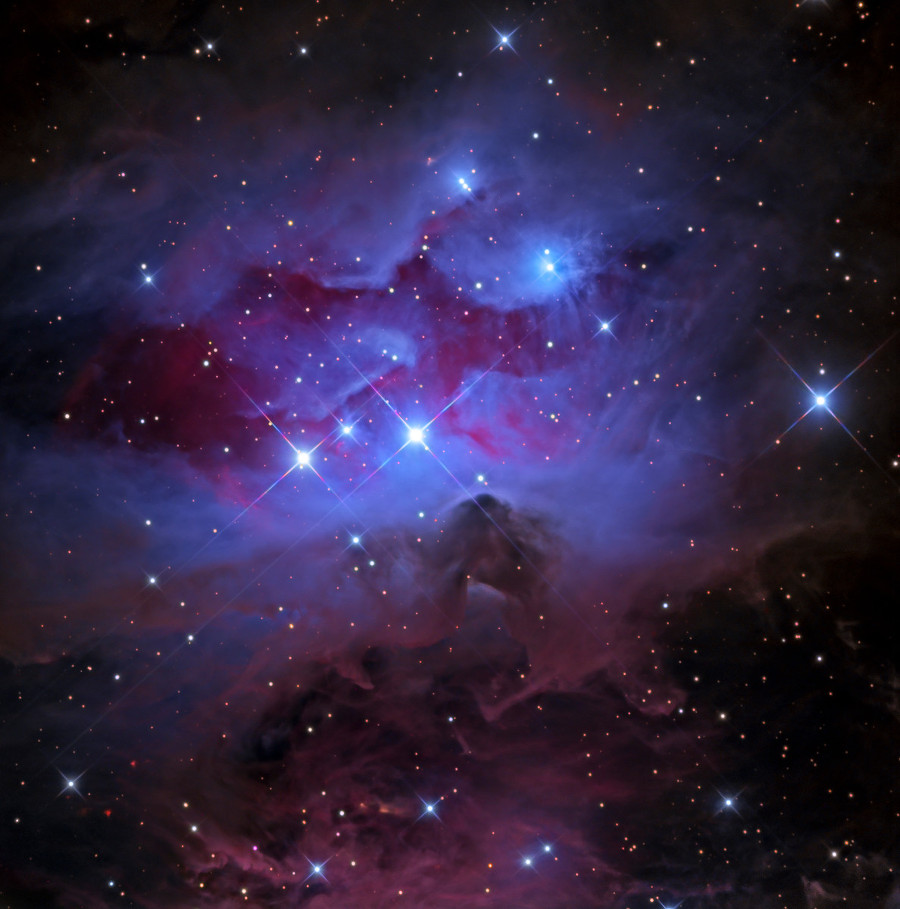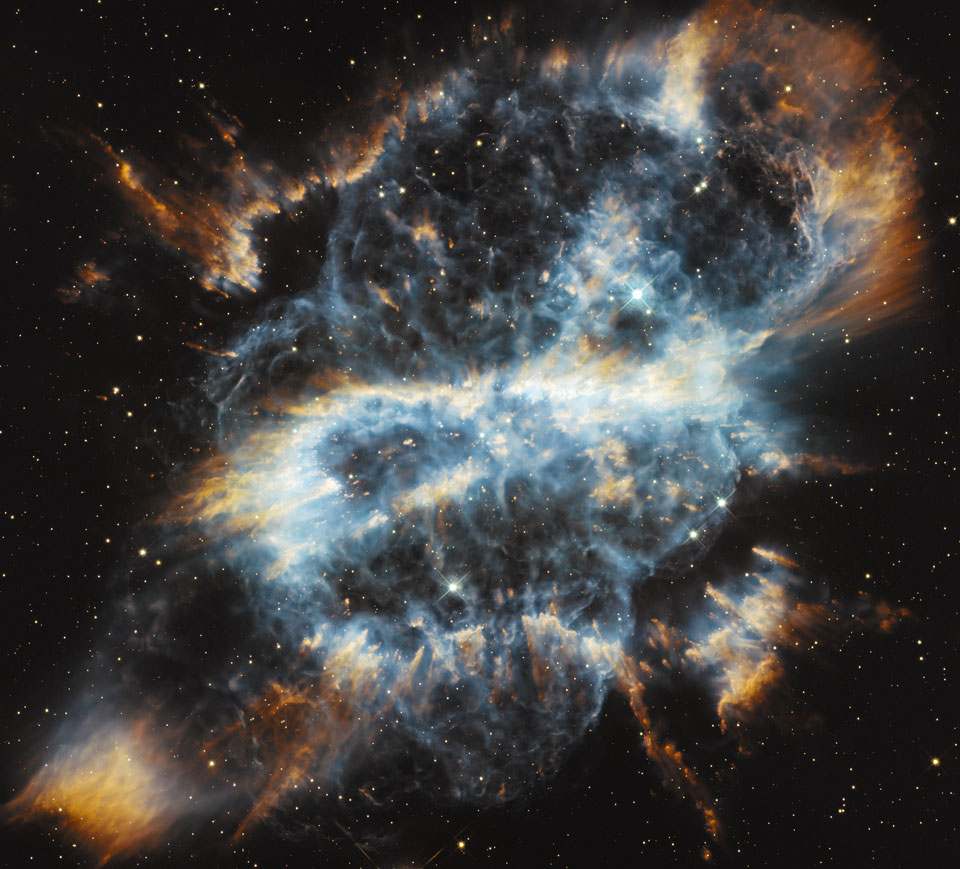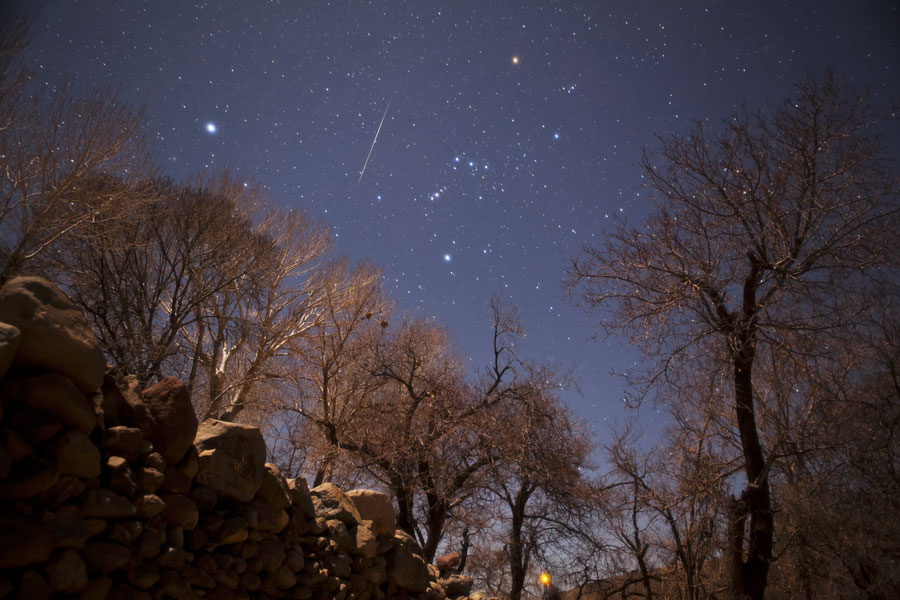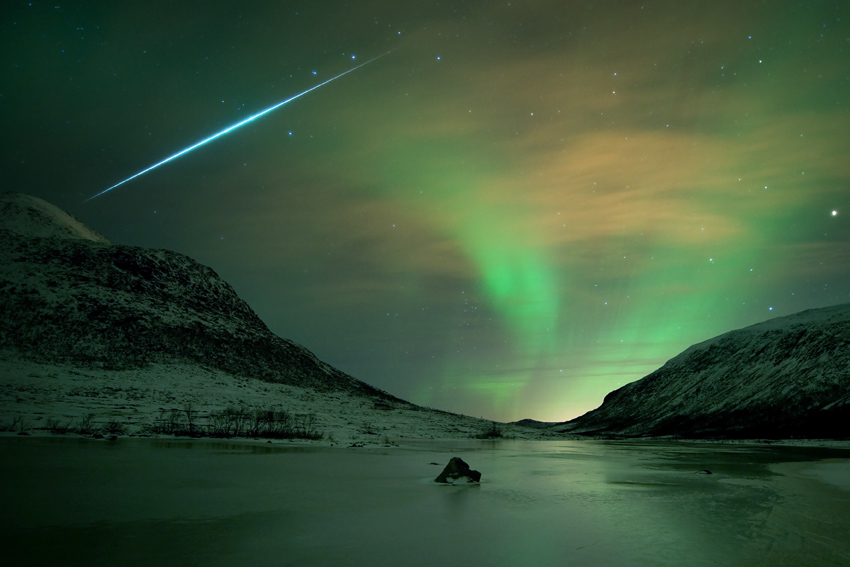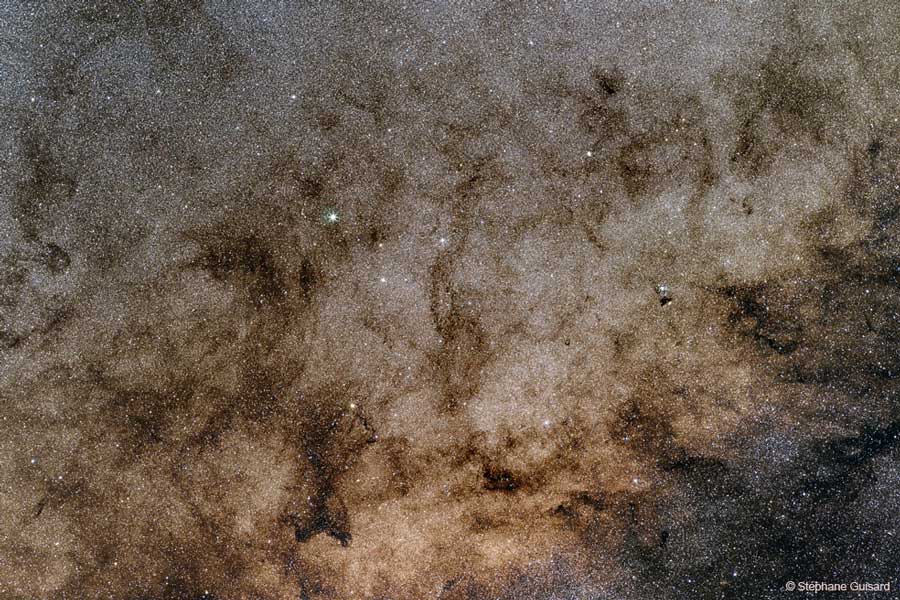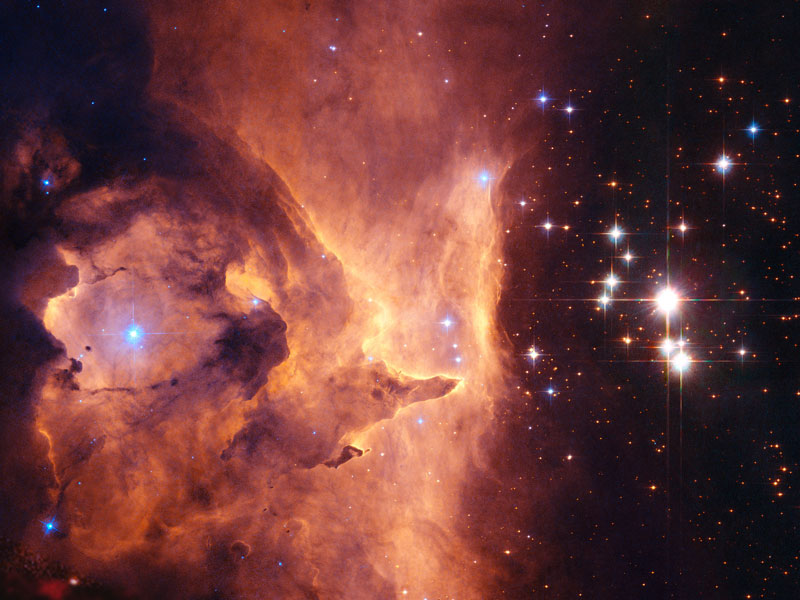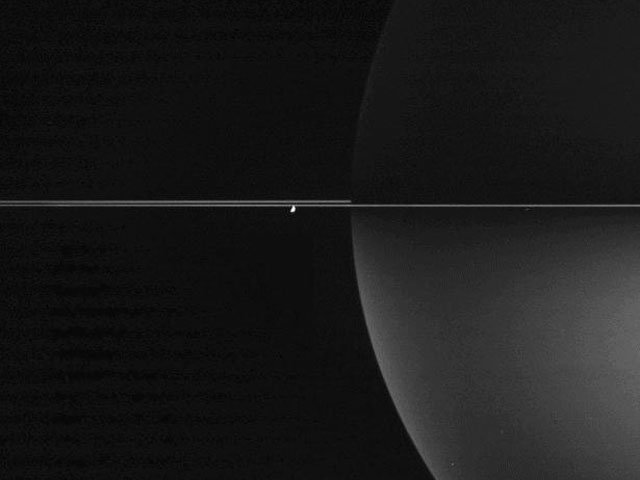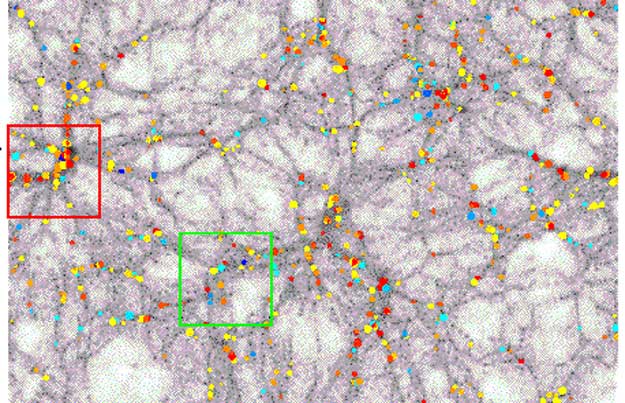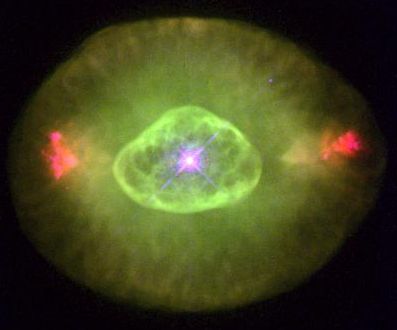| << Previous | Index | Next >> |
2014 The 1970s are sometimes ignored by astronomers, like this beautiful grouping of reflection nebulae in Orion - NGC 1977, NGC 1975, and NGC 1973 - usually overlooked in favor of the substantial glow from the nearby stellar nursery better known as the Orion Nebula. Found along Orion's sword just north of the bright Orion Nebula complex, these reflection nebulae are also associated with Orion's giant molecular cloud about 1,500 light-years away, but are dominated by the characteristic blue color of interstellar dust reflecting light from hot young stars. In this sharp color image a portion of the Orion Nebula appears along the bottom border with the cluster of reflection nebulae at picture center. NGC 1977 stretches across the field just below center, separated from NGC 1973 (above right) and NGC 1975 (above left) by dark regions laced with faint red emission from hydrogen atoms. Taken together, the dark regions suggest to many the shape of a running man.
2013 The Moon is normally seen in subtle shades of grey or yellow. But small, measurable color differences have been greatly exaggerated to make this telescopic, multicolored, moonscape captured during the Moon's full phase. The different colors are recognized to correspond to real differences in the chemical makeup of the lunar surface. Blue hues reveal titanium rich areas while orange and purple colors show regions relatively poor in titanium and iron. The familiar Sea of Tranquility, or Mare Tranquillitatis, is the blue area in the upper right corner of the frame. White lines radiate across the orange-hued southern lunar highlands from 85 kilometer wide ray crater Tycho at bottom left. Above it, darker rays from crater Copernicus extend into the Sea of Rains (Mare Imbrium) at the upper left. Calibrated by rock samples from the Apollo missions, similar multicolor images from spacecraft have been used to explore the Moon's global surface composition.
2012 Why is this nebula so complex? When a star like our Sun is dying, it will cast off its outer layers, usually into a simple overall shape. Sometimes this shape is a sphere, sometimes a double lobe, and sometimes a ring or a helix. In the case of planetary nebula NGC 5189, however, no such simple structure has emerged. To help find out why, the Earth-orbiting Hubble Space Telescope recently observed NGC 5189 in great detail. Previous findings indicated the existence of multiple epochs of material outflow, including a recent one that created a bright but distorted torus running horizontally across image center. Results appear consistent with a hypothesis that the dying star is part of a binary star system with a precessing symmetry axis. Given this new data, though, research is sure to continue. NGC 5189 spans about three light years and lies about 3,000 light years away toward the southern constellation of the Fly (Musca).
2011 Some beautiful things begin as grains of sand. Locked in an oyster, a granule grows into an iridescent pearl, lustrous and lovely to behold. While hurtling through the atmosphere at 35 kilometers per second, a generous cosmic sand grain becomes an awe-inspiring meteor, its transient beauty displayed for any who care to watch. This years Geminid meteor shower peaked last week with sky enthusiasts counting as many as 150 meteors per hour, despite the din of bright moon. Pictured above the Taftan volcano in southeast Iran, a meteor streaks between the bright star Sirius on the far left and the familiar constellation of Orion toward the image center. Sky watchers are looking forward to next years Geminids which should peak during an unobstructive new Moon.
2010
2009 Northern Lights, or aurora borealis, haunted skies over the island of Kvaløya, near Tromsø Norway on December 13. This 30 second long exposure records their shimmering glow gently lighting the wintery coastal scene. A study in contrasts, it also captures the sudden flash of a fireball meteor from December's excellent Geminid meteor shower. Streaking past familiar stars in the handle of the Big Dipper, the trail points back toward the constellation Gemini, off the top of the view. Both aurora and meteors occur in Earth's upper atmosphere at altitudes of 100 kilometers or so, but aurora are caused by energetic charged particles from the magnetosphere, while meteors are trails of cosmic dust.
2008 The 16th century Portuguese navigator Ferdinand Magellan and his crew had plenty of time to study the southern sky during the first circumnavigation of planet Earth. As a result, two fuzzy cloud-like objects easily visible to southern hemisphere skygazers are known as the Clouds of Magellan, now understood to be satellite galaxies of our much larger, spiral Milky Way galaxy. About 160,000 light-years distant in the constellation Dorado, the Large Magellanic Cloud (LMC) is seen here in a remarkably detailed, 10 frame mosaic image. Spanning about 30,000 light-years or so, it is the most massive of the Milky Way's satellite galaxies and is the site of the closest supernova in modern times, SN 1987A. The prominent reddish knot near the bottom is 30 Doradus, or the Tarantula Nebula, a giant star-forming region in the Large Magellanic Cloud. To identify the location of the supernova and navigate your way around the many star clusters and nebulae of the LMC, just consult this well-labeled view.
2007 Billions of stars light up the direction toward the center of our Galaxy. The vast majority of these stars are themselves billions of years old, rivaling their home Milky Way Galaxy in age. Together with interstellar dust, these old stars combine to create this yellowish starscape. Although the opaque dust obscures the true Galactic center in visible light, there is a low density hole in the dust on the right of the image. The region, named Baade's Window for the German astronomer who studied it, is used to inspect distant stars and to determine the internal geometry of the Milky Way. Baade's Window lies toward the constellation of the Archer (Sagittarius).
2006 How massive can a normal star be? Estimates made from distance, brightness and standard solar models had given one star in the open cluster Pismis 24 over 200 times the mass of our Sun, making it a record holder. This star is the brightest object located just to the right of the gas front in the above image. Close inspection of images taken recently with the Hubble Space Telescope, however, have shown that Pismis 24-1 derives its brilliant luminosity not from a single star but from three at least. Component stars would still remain near 100 solar masses, making them among the more massive stars currently on record. Toward the image left, stars are still forming in the associated emission nebula NGC 6357, including several that appear to be breaking out and illuminating a spectacular cocoon.
2005 How thin are the rings of Saturn? Brightness measurements from different angles have shown Saturn's rings to be about one kilometer thick, making them many times thinner, in relative proportion, than a razor blade. This thinness sometimes appears in dramatic fashion during an image taken nearly along the ring plane. The robot Cassini spacecraft now orbiting Saturn has now captured another shot that dramatically highlights the ring's thinness. The above artistic looking image was taken early last month in infrared polarized light. If alone in space, the unlit part of Saturn would be much darker. Reflection of light off of moons like Enceladus (pictured) and the billions of small particles in Saturn's rings, however, gives the giant space orb an unusual glow, an effect highlighted in polarized light.
2004 Where did all the stars go? What used to be considered a hole in the sky is now known to astronomers as a dark molecular cloud. Here, a high concentration of dust and molecular gas absorb practically all the visible light emitted from background stars. The eerily dark surroundings help make the interiors of molecular clouds some of the coldest and most isolated places in the universe. One of the most notable of these dark absorption nebulae is a cloud toward the constellation Ophiuchus known as Barnard 68, pictured above. That no stars are visible in the center indicates that Barnard 68 is relatively nearby, with measurements placing it about 500 light-years away and half a light-year across. It is not known exactly how molecular clouds like Barnard 68 form, but it is known that these clouds are themselves likely places for new stars to form. It is possible to look right through the cloud in infrared light.
2003 Spectacular first images from the newly christened Spitzer Space Telescope include this penetrating interior view of an otherwise opaque dark globule known as the Elephant's Trunk Nebula. Seen in a composite of infrared image data recorded by Spitzer's instruments, the intriguing region is embedded within the glowing emission nebula IC 1396 at a distance of 2,450 light-years toward the constellation Cepheus. Previously undiscovered protostars hidden by dust at optical wavelengths appear as bright reddish objects within the globule. Shown in false-color, winding filaments of infrared emission span about 12 light-years and are due to dust, molecular hydrogen gas, and complex molecules called polycyclic aromatic hydrocarbons or PAHs. The Spitzer Space Telescope was formerly known as the Space Infrared Telescope Facility (SIRTF) and is designed to explore the Universe at infrared wavelengths. Spitzer follows the Hubble Space Telescope, the Compton Gamma-ray Observatory, and the Chandra X-ray Observatory as the final element in NASA's space-borne Great Observatories Program.
2002 On December 11 astronomers found one of the brightest and most distant explosions in the Universe - a gamma-ray burst - hiding in the glare of a relatively nearby star. The earliest image of the burst's visible light was caught by an earthbound RAPTOR (RAPid Telescopes for Optical Response). The two exposures inset above were taken by a RAPTOR unit about 65 seconds (left) and 9 minutes (top right) after high-energy radiation from the burst, dutifully cataloged as GRB 021211, was identified by the orbiting HETE-2 satellite. One of only two optical transients (OTs) ever found at times so close to a burst's gamma-ray emission, the fading visible light source is indicated by arrows, blended with the image of foreground stars toward the constellation Canis Minor. The RAPTOR unit (lower inset) is designed with peripheral low resolution cameras and a central, sensitive high resolution imager, in analogy with a predator's vision. In the future, the RAPTOR project expects its innovative instruments to be able to independently discover and catalog a host of cosmic things that go bump in the night.
2001 Where is dark matter? Galaxies rotate and move in clusters as if a tremendous amount of unseen matter is present. But does dark matter exist in the greater universe too -- and if so, where? The answer can be found by comparing the distribution of galaxies observed with numerical simulations. This comparison became much more accurate recently when over 100,000 galaxy observations from the 2-Degree Field Galactic Redshift Survey were used. In the above frame from a computer simulation of our universe, a 300 million light-year slice shows dark matter in gray and galaxies as colored circles. The red box indicates the location of a rich cluster of galaxies, while the green box shows a more typical cross-section of our universe. Analyses indicate that the immense gravity of the pervasive dark matter pulls normal matter to it, so that light matter and dark matter actually cluster together.
2000 Jupiter has aurorae. Like Earth, the magnetic field of the gas giant funnels charged particles released from the Sun onto the poles. As these particles strike the atmosphere, electrons are temporarily knocked away from existing gas molecules. Electric force attracts these electrons back. As the electrons recombine to remake neutral molecules, auroral light is emitted. In the above recently released photograph by the Hubble Space Telescope taken in ultraviolet light, the aurorae appear as annular sheets around the pole. Unlike Earth's aurorae, Jupiter's aurorae include several bright streaks and dots. These marks are caused by magnetic flux tubes connecting Jupiter to its largest moons. Specifically, Io caused the bright streak on the far left, Ganymede caused the bright dot below center, and Europa caused the dot to its right.
1999 Our Sun is unusual in that it is alone - most stars occur in multiple or binary systems. In a binary system, the higher mass star will evolve faster and will eventually become a compact object - either a white dwarf star, a neutron star, or black hole. When the lower mass star later evolves into an expansion phase, it may be so close to the compact star that its outer atmosphere actually falls onto the compact star. Such is the case diagrammed above. Here gas from a blue giant star is shown being stripped away into an accretion disk around its compact binary companion. Gas in the accretion disk swirls around, heats up, and eventually falls onto the compact star. Extreme conditions frequently occur on the surface of the compact star as gas falls in, many times causing detectable X-rays, gamma-rays, or even cataclysmic novae explosions. Studying the extreme conditions in these systems tells us about the inner properties of ordinary matter around us.
1998 By chance, a collision of two galaxies has created a surprisingly recognizable shape on a cosmic scale - "The Cartwheel Galaxy". The Cartwheel is part of a group of galaxies about 500 million light years away in the constellation Sculptor (two smaller galaxies in the group are visible on the right). Its rim is an immense ring-like structure 100,000 light years in diameter composed of newly formed, extremely bright, massive stars. When galaxies collide they pass through each other, their individual stars rarely coming into contact. However, the galaxies' gravitational fields are seriously distorted by the collision. In fact, the ring-like shape is the result of the gravitational disruption caused by a small intruder galaxy passing through a large one, compressing the interstellar gas and dust and causing a a star formation wave to move out from the impact point like a ripple across the surface of a pond. In this case the large galaxy may have originally been a spiral, not unlike our own Milky Way, transformed into the wheel shape by the collision. But ... what happened to the small intruder galaxy?
1997 The colorful planetary nebula phase of a sun-like star's life is brief. Almost in the "blink of an eye" - cosmically speaking - the star's outer layers are cast off, forming an expanding emission nebula. This nebula lasts perhaps 10 thousand years compared to a 10 billion year stellar life span. Spectacular planetary nebulae are familiar objects to both professional and amateur astronomers, but they still contain a few surprises. For instance, the lovely nebula NGC 6826, also known as the Blinking Eye Nebula, has mysterious red FLIERS seen on either side of the Hubble Space Telescope image above. Are they also expanding outward from the central star? If so, their "bow shocks" point in the wrong direction!
1996 Headed toward the inner Solar System, the much anticipated Comet Hale-Bopp has promised to put on a big show next spring. The comet's apparent brightness is currently approaching 4th magnitude and its inbound journey has been closely followed by many observers. But because it is now so near the Sun's position in the sky it is a difficult target for large ground based optical telescopes as well as the orbiting Hubble Space Telescope (HST). This series of HST images hints at the comet's evolution during the last year, illustrating active and quiescent phases. Hidden from direct view by the dusty cometary coma, Hale-Bopp's nucleus is centered in each frame. A single telescopic image of the comet has recently caused substantial activity on the internet based on false claims of the existence of a mysterious companion. However, the mystery guest turned out to be an 8th magnitude star! Many predict that by next spring telescopes large or small will not be needed to appreciate the true spectacle of Hale-Bopp as it blossoms into a naked-eye astronomical wonder.
1995 Albert Einstein is considered by many the greatest astrophysicist. He is pictured here in the Swiss Patent Office where he did much of his great work. Einstein's many visionary scientific contributions include the equivalence of mass and energy (E=mc^2), how the maximum speed limit of light affects measurements of time and space (special relativity), and a more accurate theory of gravity based on simple geometric concepts (general relativity). One reason Einstein was awarded the 1921 Nobel Prize in Physics was to make the prize more prestigious.
| << Previous | Index | Next >> |
